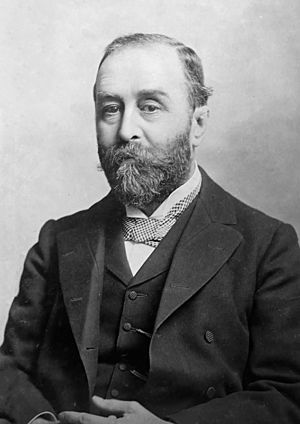Thornley Stoker facts for kids
Sir William Thornley Stoker, 1st Baronet (born March 6, 1845 – died July 1912), was an Irish doctor, writer, and surgeon. He was a very important person in medicine in Ireland. He led the anatomy department and was president of the Royal College of Surgeons in Ireland. He also served as president of the Royal Academy of Medicine in Ireland. Plus, he taught anatomy at the Royal Hibernian Academy, which is an art school.
Contents
Early Life and Family
William Thornley Stoker was born to Abraham Stoker (1799–1876) from Dublin and Charlotte Mathilda Blake Thornley (1818–1901). His mother, Charlotte, was a feminist, meaning she believed women should have equal rights. She grew up in Sligo Town. William was the oldest of seven children. His younger brother was Bram Stoker, who became a very famous writer, known for his book Dracula.
Education and Home
William went to a private school in England. Later, he studied at the Royal College of Surgeons in Ireland in Dublin. He also attended Queen's College, Galway. He earned his M.D. degree (which means he became a doctor) in 1866. In his later life, he lived in a grand house called Ely House in Ely Place, Dublin. Many artists and writers visited him there.
Medical Career and Achievements
William Thornley Stoker started his career by teaching medicine to students. After a few years, he became a surgeon at the Royal City of Dublin Hospital. In 1873, he moved to the Richmond Hospital.
Leadership in Medicine
From 1876, he was in charge of the Anatomy department at the Royal College of Surgeons in Ireland. He held this important position for several years. He also became a surgeon at Swift's Hospital, which was founded by the writer Jonathan Swift. He helped manage both Swift's Hospital and the Richmond Hospital.
With his brother-in-law, Richard Thomson, he started a nursing school at the Richmond Hospital. They also oversaw the building of new surgery rooms there in 1899. He later took over from Richard Thomson as the person who checked how medical research was done on animals in Ireland. He made sure it was done properly and kindly.
Writing and Campaigns
While working in hospitals, William often wrote articles for medical journals. He wrote about many different medical topics. He was especially interested in surgery of the brain and spine. He also cared deeply about social issues. He spoke out against the Workhouse system, which were places for very poor people that often had harsh conditions. He also campaigned against cruelty to animals.
Later Roles and Honors
In 1896, he became the president of the Royal College of Surgeons in Ireland. From 1903 to 1906, he was president of the Royal Academy of Medicine. William also had a strong interest in art. He taught anatomy at the Royal Hibernian Academy. He was also a governor of the National Gallery of Ireland, which is a major art museum.
In 1910, he retired from many of his medical duties because he was tired. The next year, he received a special honor from the King. He was made a baronet, which is a title like "Sir" that can be passed down in a family. He was known as Sir William Thornley Stoker, 1st Baronet, of Hatch Street in Dublin. He passed away in July 1912, at the age of 67. Since he had no children to pass the title to, the baronetcy ended with him.


